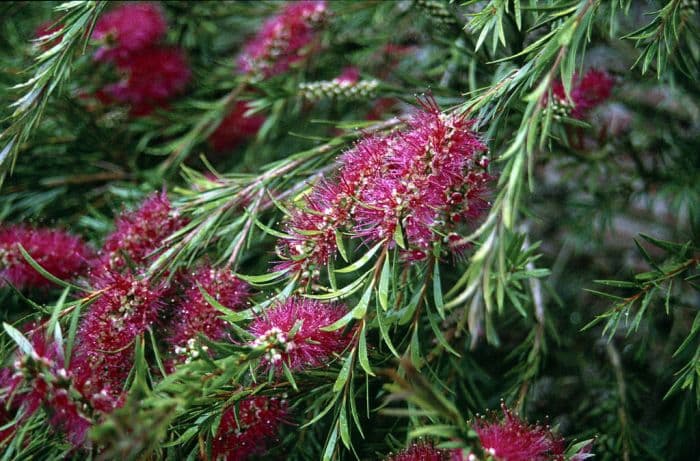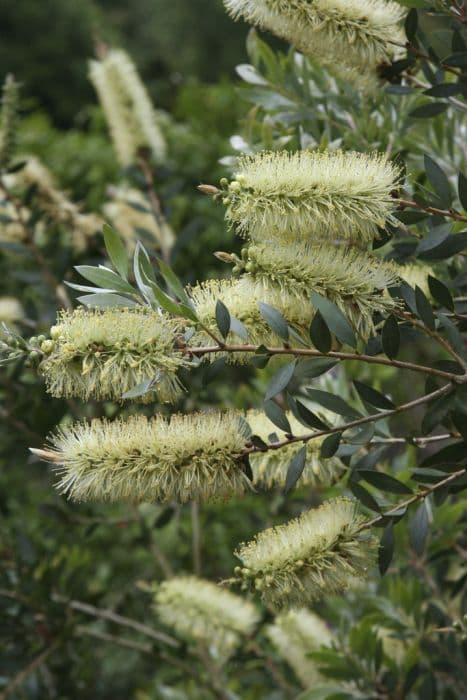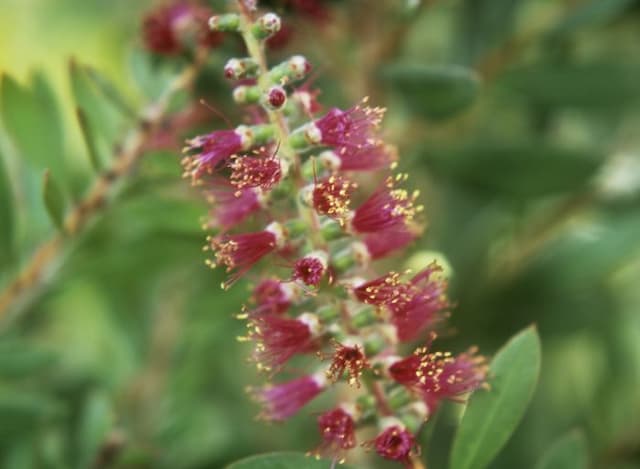Bottlebrush Callistemon rigidus

ABOUT
Callistemon rigidus, commonly known as the stiff bottlebrush, is a visually striking plant known for its unique and vibrant flower spikes. This plant's most prominent feature is its cylindrical, brush-like flowers. These blooms are made up of numerous small flowers, each with prominent stamens that give the flower spikes a fuzzy appearance. They are typically bright red, creating a stunning contrast against the foliage. The stiff bottlebrush has narrow, lance-shaped leaves that are often a deep green, giving a lush backdrop to the vivid flowers. The stiff bottlebrush's flowers attract a variety of wildlife, including birds and insects, which are drawn to the plant for its nectar. These red, brush-like blooms can give the garden a splash of color, particularly when they appear in their prime blooming season. The leaves may also exude a light fragrance when crushed, adding another layer of sensory appeal to the plant. Overall, the stiff bottlebrush has a robust and rigid stance, living up to its common name. Its evergreen nature ensures that it provides year-round interest in the garden, with the peak visual spectacle occurring when it is laden with its characteristic bottlebrush flowers.
About this plant
 Names
NamesFamily
Myrtaceae
Synonyms
Stiff Bottlebrush, Rigid Bottlebrush
Common names
Melaleuca rigidus, Callistemon lanceolatus, Metrosideros lanceolata.
 Toxicity
ToxicityTo humans
The plant Callistemon rigidus, commonly known as Bottlebrush, is not known to be toxic to humans. However, it is always possible that some people might have a sensitive reaction to the plant. In the absence of substantial toxicity reports, it is generally considered safe, but ingesting any plant material may cause gastrointestinal discomfort for sensitive individuals.
To pets
Bottlebrush, or Callistemon rigidus, is not known to be toxic to pets. There is no widespread report of pets being poisoned by consuming parts of the Bottlebrush plant. Nonetheless, pets may still experience mild stomach upset if they chew on or ingest parts of the plant, as with any non-food plant material.
 Characteristics
CharacteristicsLife cycle
Perennials
Foliage type
Evergreen
Color of leaves
Green
Flower color
Red
Height
6-10 feet (1.8-3 meters)
Spread
4-6 feet (1.2-1.8 meters)
Plant type
Shrub
Hardiness zones
8
Native area
Australia
Benefits
 General Benefits
General Benefits- Ornamental Value: Callistemon rigidus, commonly known as the stiff bottlebrush, is a visually striking plant, known for its vibrant red flowers that resemble a traditional bottle brush.
- Attracts Wildlife: It is known to attract pollinators such as bees, butterflies, and birds, particularly hummingbirds, which can help pollinate other plants in the garden.
- Drought Tolerance: Stiff bottlebrush is known for its ability to withstand periods of drought once established, making it suitable for xeriscaping and low-water gardens.
- Low Maintenance: It requires minimal care once established, with little need for fertilization or pruning, making it an excellent plant for those looking for low-maintenance gardening.
- Erosion Control: The plant can be used in landscaping to prevent soil erosion thanks to its root system that helps to stabilize the soil.
- Habitat Restoration: It can be planted as part of habitat restoration efforts to provide natural food sources and shelter for wildlife.
- Privacy Screening: When planted in groups or rows, stiff bottlebrush can act as a natural privacy screen due to its dense foliage and growth habit.
- Soil Improvement: It can help improve soil structure and quality over time as it adds organic matter when leaves and flowers drop and decompose.
- Windbreak: The stiff bottlebrush can be used as a windbreak in coastal or windy areas to protect gardens and homes from strong winds.
- Adaptability: The plant is adaptable to a variety of soil types, although it prefers well-draining soil, which means it can be grown in many regions with relative ease.
 Medical Properties
Medical Properties- This plant is not used for medical purposes.
 Air-purifying Qualities
Air-purifying QualitiesThis plant is not specifically known for air purifying qualities.
 Other Uses
Other Uses- Callistemon rigidus, commonly known as Bottlebrush, can be used in crafting and floral arrangements due to its unique and vibrant red flower spikes.
- In landscape design, Bottlebrush can serve as a natural privacy screen when planted in rows or hedges due to its dense foliage.
- The fibrous bark of Bottlebrush can be explored for its potential in textile production, particularly for creating rough fabrics or craft materials.
- Because of its resistance to drought, Bottlebrush can be used in xeriscaping, helping to reduce the need for irrigation in dry climates.
- Bottlebrush wood, being hardy and dense, can be used for making small wooden objects like handles or craft items that require a robust material.
- The Bottlebrush plant can act as a noise buffer when planted densely along highways or in urban settings, helping to absorb sound.
- During festive seasons, branches of Bottlebrush can be used as natural and biodegradable decorations due to their bright and cheerful appearance.
- As a pioneer species, the Bottlebrush can be planted in disturbed areas to help stabilize soil and prevent erosion.
- The dense, evergreen nature of the plant makes it a suitable habitat for birds and beneficial insects, providing nesting opportunities and food sources.
- Its leaves can be crushed and used as a natural insect repellent due to the aromatic oils they contain.
Interesting Facts
 Feng Shui
Feng ShuiThe Bottlebrush is not used in Feng Shui practice.
 Zodiac Sign Compitability
Zodiac Sign CompitabilityThe Bottlebrush is not used in astrology practice.
 Plant Symbolism
Plant Symbolism- Resilience: Callistemon rigidus, commonly known as the stiff bottlebrush, has a strong and hardy nature, symbolizing the ability to endure and thrive in challenging conditions.
- Purification: The bottlebrush is known to have cleansing properties, often symbolizing the act of purification and renewal.
- Attraction: With its vibrant red flowers, the stiff bottlebrush is a symbol of attraction, drawing in all manner of life, from birds to beneficial insects.
- Celebration: The bottlebrush's exuberant and colorful flowers can symbolize celebration and joy, often used during festive occasions.
- Healing: Traditionally, various species of bottlebrush have been used for medicinal purposes, representing healing and well-being.
 Water
WaterBottlebrush, or Callistemon rigidus, prefers moderate watering. During its growing season in spring and summer, water the plant thoroughly once the top inch of soil feels dry to the touch, usually every week, with about 1 to 1.5 gallons depending on the size of the plant and the pot. In fall and winter, reduce watering to every two weeks, being cautious not to overwater, as the plant enters a dormant period. It's vital to ensure the pot has good drainage to prevent root rot. Overhead watering can help keep the foliage healthy, but the focus should be on soaking the soil rather than just sprinkling the surface.
 Light
LightBottlebrush thrives best in full sun exposure, receiving at least six to eight hours of direct sunlight each day. Position the plant in a spot where it is bathed in bright sunlight, as this will promote the most vigorous growth and blooms. While it can tolerate partial shade, the blooming may be reduced and the plant may become leggy as it reaches for light.
 Temperature
TemperatureBottlebrush is hardy in a range with a minimum temperature around 20-25 degrees Fahrenheit and can survive short periods of frost, but sustaining such cold can cause damage to the plant. Ideal growth temperatures are between 40 and 90 degrees Fahrenheit. It's essential to protect the plant from extreme cold and consider moving it to a sheltered location if necessary.
 Pruning
PruningPrune bottlebrush plants to maintain shape and encourage bushier growth. Pruning should be done after the plant has flowered, typically in late spring or early summer, removing any dead or crossing branches and cutting back tips to promote new growth. Pruning can be done annually or biennially, depending on the speed of growth and the desired size of the plant.
 Cleaning
CleaningAs needed
 Soil
SoilBottlebrush plants prefer well-draining soil with a slightly acidic to neutral pH, between 6.0 and 7.0. A suitable soil mix can be made by combining equal parts loamy soil, sand, and peat moss to ensure proper drainage and aeration.
 Repotting
RepottingBottlebrush plants should be repotted every 2-3 years to provide fresh soil and accommodate root growth. Young plants may require more frequent repotting, while mature plants can be repotted less often.
 Humidity & Misting
Humidity & MistingBottlebrush plants thrive in moderate to high humidity levels, with ideal conditions ranging between 40% to 60%. They can tolerate lower humidity but prefer consistently moist atmospheric conditions.
 Suitable locations
Suitable locationsIndoor
Ensure bright indirect light, well-draining soil, and moderate humidity.
Outdoor
Full sun, well-draining soil, and protection from harsh frost.
Hardiness zone
8-11 USDA
 Life cycle
Life cycleCallistemon rigidus, commonly known as stiff bottlebrush, begins its life cycle with seed germination, which occurs best after exposure to fire or smoke that mimics its natural bushfire-prone habitat conditions. The seeds grow into seedling stage, establishing a root system and a rosette of juvenile leaves. As it enters the vegetative stage, the plant develops its distinctive rigid, needle-like foliage and woody stems, focusing on growth and energy accumulation. The stiff bottlebrush reaches maturity and starts the reproductive stage by producing vibrant red cylindrical flower spikes, consisting of numerous individual flowers, which attract pollinators such as birds and insects. After pollination, flowers give way to woody capsules, which contain numerous small seeds that are released following environmental triggers such as fire. The plant may enter a period of dormancy during adverse conditions, only to resume its growth cycle once favorable conditions return.
 Propogation
PropogationPropogation time
Spring-Early Summer
The most popular method of propagation for Callistemon rigidus, commonly known as the stiff bottlebrush, is through semi-hardwood cuttings. This involves taking a cutting of approximately 4 to 6 inches (10 to 15 centimeters) long from the current or previous year's growth during the late summer. The leaves on the lower half of the cutting are removed, and the base is often dipped in a rooting hormone to encourage root development. The cutting is then planted in a well-draining potting mix or directly into the ground in a location that receives indirect sunlight. It's important to keep the soil moist but not waterlogged to prevent rot. Under optimal conditions, roots will develop within a few weeks, and the new plants can be transplanted to their permanent location the following growing season.









